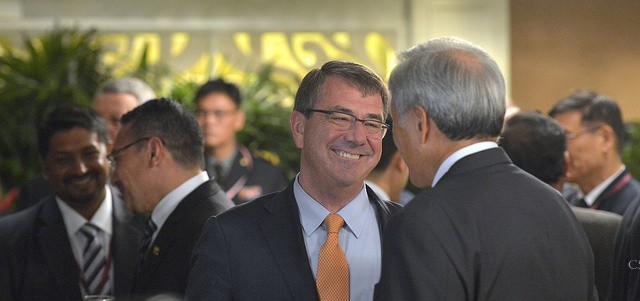On Saturday morning at the Shangri-La defense dialogue in Singapore, U.S. Secretary of Defense Ashton Carter delivered a long-anticipated speech on security issues in Asia. As tensions have mounted over China’s island building in the South China Sea, Carter has been one of the administration’s strongest voices, calling the militarization of the islands a challenge to international norms and reaffirming the United States’ intention to uphold freedom of navigation and overflight, and to defend international law. Carter’s Shangri-La speech did not disappoint; he broadened the aperture focusing on wider strategic goals for the region, he called for a regional architecture that gives all countries and people in the Asia-Pacific the right to rise, and spoke at length on the South China Sea disputes. Here are some of the prominent themes from the Secretary’s remarks.
Asia is on the ascent, and that is good for the United States. Carter pointed out that America understands and embraces the economic and geopolitical calculus that points to Asia being the most dynamic region in the world – and reminded all that the United States is Pacific nation. He hailed Asia as the fulcrum of the global economy, but reminded his audience that the U.S. economy was back in full force. He reaffirmed Washington’s and his personal commitment to the rebalance, noting new military platforms that the U.S. would deploy in the region, such as P-8 patrol aircraft and Sumgait stealth destroyers and reiterating the administration’s intent to pass the Trans-Pacific Partnership (TPP). Carter also repeated the United States’ intent to uphold rules and norms in the region, strengthen institutions, and modernize alliances and partnerships. Carter’s message to Asia was that he understands economics is the foundation for security in the region.
A strong stand on land reclamation in the South China Sea. Carter was firm and nuanced when he spoke about China’s island building in the Spratlys. He acknowledged that other claimants had also built up outposts in the area but stated that China had gone “farther and faster” with little indication of its underlying intentions. He called for a halt to land reclamation on all sides, for peaceful resolution of disputes, and said that the United States would continue to support claimants’ pursuit of international legal arbitration. Carter also put China on notice that the United States would continue to fly and sail wherever international law allows, noting that the construction of an artificial island with an airstrip did not confer sovereign rights or permit restrictions on air and maritime transit. He rebuked China’s building as inimical to international rules and norms, and noted that it was catalyzing new balancing partnerships in the region as other states sought to respond. All Asian countries noted his reiteration of the U.S. commitment to the Philippines during the swearing in of Admiral Harry Harris at PACOM on his way to Singapore.
In the question and answer portion of the address, Carter handled steadily three frank questions on China’s land reclamation and Washington’s responses. The Secretary refused to speculate on China’s long-term intentions for its outposts. He stated that China and not the United States was creating new facts in the South China Sea and noted that many countries in the region shared U.S. concern about China’s behavior.
Carter also took a question from Chinese PLA Colonel Zhou, who argued that China’s Spratly activities were legitimate and justified. Carter responded that the United States was calling for a halt to land reclamation from all sides, and stated that U.S. patrols of the seas and skies of the region were longstanding and would continue.
Charting the way forward. Carter noted that the United States was preparing to sign a new Joint Vision Statement with Vietnam and a Defense Framework with India, but his most significant policy reveal was the official debut of a new Southeast Asia Maritime Security Initiative. If implemented, the Pentagon-sponsored fund could give up to $425 million dollars for partner capacity building efforts in the region over the next several years, but it may meet with resistance due to Sequestration.
On the diplomatic front, Carter reiterated the perennial call for China and ASEAN to sign a binding Code of Conduct. The speech did not provide a complete roadmap for U.S. strategy in the South China Sea, but this should not come as a surprise—Carter rightly aimed his message at longer term more strategic ideas. The United States’ contribution to Asia’s peace and prosperity, and therefore its investment in its own security and economic future, is based on broader goals. Carter’s comments underscored the need for regional unity and implicitly acknowledged hesitance among some other states when it comes to signaling to China that all want it to be successful and secure, but not at the expense of its neighbors’ sovereignty.
The United States knows that it needs buy-in from regional partners if new proposals are to be viable, so a public speech at a high-level defense forum were not the right place to test the waters with a new grand plan. Carter acknowledged the importance of the U.S.-China relationship on issues such as North Korea, and reassurance towards Beijing remains an important part of any U.S. strategy.
The bottom line. Carter has clearly emerged as the Obama administration’s point-man on Asia. He and the new Pacific Commander, Harry Harris, appear to be pushing for a more robust U.S. response to Beijing’s “cabbage peeling” strategy of coercion in the South China Sea. An important part of that strategy will be demonstrating to Beijing that the United States is willing to tolerate a higher degree of risk in order to dissuade China from further destabilizing moves such as militarizing the newly reclaimed land facilities or declaring an Air Defense Identification Zone over the area. It is not clear whether the White House has the same appetite for risk or whether Beijing will now be dissuaded from its current accelerated path.
This article originally appeared on CSIS.org.
